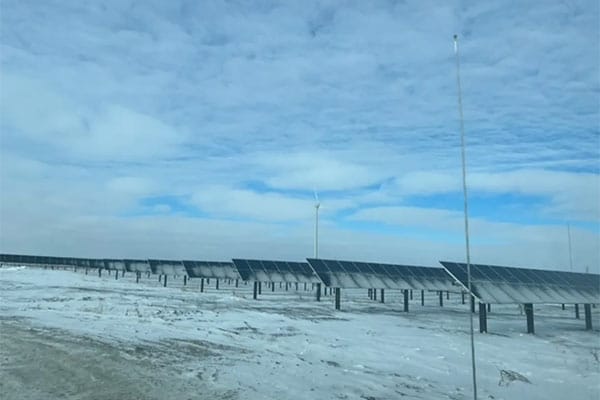The $21-million Awasis solar project is located on Cowessess First Nation reserve land, roughly three kilometres southeast of Regina. The official grand opening of the Awasis solar project was last Wednesday.
The multimillion-dollar solar power project will bring the First Nation community economic prosperity for the next 20 years, according to Cowessess Chief Cadmus Delorme. The Cowessess First Nation primarily owns the project, and is now live.
The project’s name holds special significance: “Awasis” is the Cree name of the Cowessess’s last hereditary chief, Littlechild. The Awasis solar project’s name is a gesture to honor the chief, “who agreed to the treaty, which led us to this relationship today,” said Cowessess Chief Cadmus Delorme.
According to SaskPower, the project will generate enough solar energy to provide power to approximately 2,500 homes per year. The Awasis solar project will supply an estimated 10 megawatts of solar energy to the provincial grid.
“What Cowessess is doing today, you can do too,” Chief Cadmus Delorme said at a celebration event Wednesday afternoon. Delorme is hopeful the Awasis project will help inspire other Saskatchewan First Nations to undertake solar energy projects, “Just make sure you are at the table, knowing your values and empowering specialists to help lead a project of this nature to what we know we are capable of.”
The solar project was developed by Awasis Solar LP, and was a partnership between Cowessess First Nation and Elemental Energy. Currently, Cowessess owns 95 percent of Awasis, and Elemental Energy owns the remaining 5 percent. According to Chief Delorme, the First Nation will have full ownership of the project in the first five years.
Delorme is hopeful the solar fields on Cowessess First Nation land will have ripple effect on the children and youth of his community. Growing up around successful renewable energy projects may inspire youth to think about studying science and engineering. “This is our contribution to getting them excited about what they’re going to do in university,” Delorme said.
The other existing solar arrays on Cowessess First Nation land were part of the Community Building Solar Project, which the federal government primarily funded for years in the making. It included more than 800 panels, installed across five community buildings: the school, the mall, the water treatment plant, the senior’s center, and the band office.
Awasis is the latest step towards Cowessess’s goal of becoming the greenest First Nation in Canada.
Revenue from the Awasis project will be “reinvested in our renewable energy projects. Secondly, some of the profit will go to unfunded areas — language, family and culture off and on reserve,” Delorme said.
Delorme credits the Truth and Reconciliation Commission’s Call to Action 92, which focuses on economic reconciliation, for helping make the Awasis project a reality. The federal government was able to provide $18.5 million to Awasis for the project, allowing Cowessess to partner with companies like Elemental Energy and actualize the project.
Chief Cadmus Delorme says he hopes the solar fields will inspire the Saskatchewan community’s children and youth. “It’s going to have ripple effects into our education,” Delorme said. “Now that our kids get to see this, we’re now looking to prepare them for science and engineering. This is our contribution to getting them excited about what they’re going to do in university.”
The solar arrays are part of the Community Building Solar Project, which has been years in the making and was mostly funded by the federal government. It’s also a step toward the Cowessess’s goal of becoming the greenest First Nation in Canada. More than 800 panels were installed on five community buildings: the school, seniors centre, mall, water treatment plant and band office.
Federal Natural Resources Minister Jonathan Wilkinson, attended Wednesday’s event and commented on how Canadians could be thinking about renewable energy projects moving forward:
“I think we all agree that we need to be thinking about how we build more renewable energy and non-emitting sources of energy into our grids. It’s going to be critical not only to achieve our climate goals but also to have a competitive economy going forward. Awasis is a great example of partnership between the province, the federal government and, of course, the First Nation who led the project,” said Wilkinson.
The impact of the Awasis solar project is significant. It’s expected to reduce greenhouse gas emissions by approximately 14,000 tonnes in its first year of operations alone, according to a federal government news release, and by roughly 350,000 tonnes over the 35-year expected lifespan of the project. According to the federal news release, the total amount reduced is equivalent to the emissions of over 70,000 gas-powered cars driven for one year.
The Awasis project has created training and skills opportunities for the Indigenous community and will continue to generate a sizeable income that can be reinvested in future clean energy initiatives and community priorities.













Comments